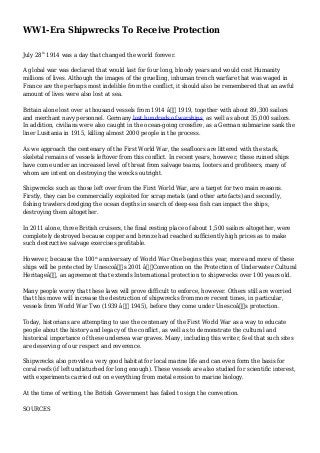WW1-Era Shipwrecks To Receive Protection
•
0 gostou•169 visualizações
July 28th 1914 was a day that changed the world forever. A global war was declared that would last f...
Denunciar
Compartilhar
Denunciar
Compartilhar
Baixar para ler offline

Recomendados
Mais conteúdo relacionado
Destaque
Destaque (20)
Product Design Trends in 2024 | Teenage Engineerings

Product Design Trends in 2024 | Teenage Engineerings
How Race, Age and Gender Shape Attitudes Towards Mental Health

How Race, Age and Gender Shape Attitudes Towards Mental Health
AI Trends in Creative Operations 2024 by Artwork Flow.pdf

AI Trends in Creative Operations 2024 by Artwork Flow.pdf
Content Methodology: A Best Practices Report (Webinar)

Content Methodology: A Best Practices Report (Webinar)
How to Prepare For a Successful Job Search for 2024

How to Prepare For a Successful Job Search for 2024
Social Media Marketing Trends 2024 // The Global Indie Insights

Social Media Marketing Trends 2024 // The Global Indie Insights
Trends In Paid Search: Navigating The Digital Landscape In 2024

Trends In Paid Search: Navigating The Digital Landscape In 2024
5 Public speaking tips from TED - Visualized summary

5 Public speaking tips from TED - Visualized summary
Google's Just Not That Into You: Understanding Core Updates & Search Intent

Google's Just Not That Into You: Understanding Core Updates & Search Intent
The six step guide to practical project management

The six step guide to practical project management
Beginners Guide to TikTok for Search - Rachel Pearson - We are Tilt __ Bright...

Beginners Guide to TikTok for Search - Rachel Pearson - We are Tilt __ Bright...
WW1-Era Shipwrecks To Receive Protection
- 1. WW1-Era Shipwrecks To Receive Protection July 28th 1914 was a day that changed the world forever. A global war was declared that would last for four long, bloody years and would cost Humanity millions of lives. Although the images of the gruelling, inhuman trench warfare that was waged in France are the perhaps most indelible from the conflict, it should also be remembered that an awful amount of lives were also lost at sea. Britain alone lost over a thousand vessels from 1914 – 1919, together with about 89,300 sailors and merchant navy personnel. Germany lost hundreds of warships, as well as about 35,000 sailors. In addition, civilians were also caught in the ocean-going crossfire, as a German submarine sank the liner Lusitania in 1915, killing almost 2000 people in the process. As we approach the centenary of the First World War, the seafloors are littered with the stark, skeletal remains of vessels leftover from this conflict. In recent years, however, these ruined ships have come under an increased level of threat from salvage teams, looters and profiteers, many of whom are intent on destroying the wrecks outright. Shipwrecks such as those left over from the First World War, are a target for two main reasons. Firstly, they can be commercially exploited for scrap metals (and other artefacts) and secondly, fishing trawlers dredging the ocean depths in search of deep-sea fish can impact the ships, destroying them altogether. In 2011 alone, three British cruisers, the final resting place of about 1,500 sailors altogether, were completely destroyed because copper and bronze had reached sufficiently high prices as to make such destructive salvage exercises profitable. However, because the 100th anniversary of World War One begins this year, more and more of these ships will be protected by Unesco’s 2001 ‘Convention on the Protection of Underwater Cultural Heritage’, an agreement that extends International protection to shipwrecks over 100 years old. Many people worry that these laws will prove difficult to enforce, however. Others still are worried that this move will increase the destruction of shipwrecks from more recent times, in particular, vessels from World War Two (1939 – 1945), before they come under Unesco’s protection. Today, historians are attempting to use the centenary of the First World War as a way to educate people about the history and legacy of the conflict, as well as to demonstrate the cultural and historical importance of these undersea war graves. Many, including this writer, feel that such sites are deserving of our respect and reverence. Shipwrecks also provide a very good habitat for local marine life and can even form the basis for coral reefs (if left undisturbed for long enough). These vessels are also studied for scientific interest, with experiments carried out on everything from metal erosion to marine biology. At the time of writing, the British Government has failed to sign the convention. SOURCES